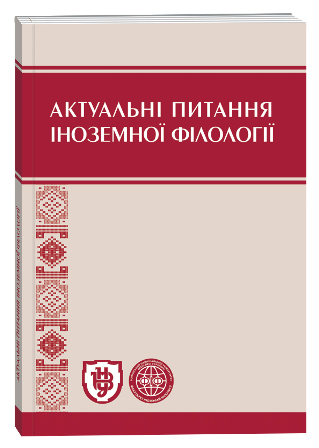CORPUS-CONTEXUAL ANALYSIS OF THE LEXICAL ASPECT: SEMELFACTIVES VS ACHIVEMENTS
DOI:
https://doi.org/10.32782/2410-0927-2021-15-14Keywords:
aspectuality, telicity, semelfactive, achivements, predicateAbstract
The article is devoted to the analysis of the aspectual classification of predicates in modern English. In particular, the classifications of M. Moens, C. Smith, D. Dowty, J. Dölling, Z. Vendler are analyzed. Verbs of the class of semelfactives and achievements are also considered. Lexical and grammatical types of the aspectuality of the predicate are examined. Particular attention is paid to the dynamism, duration and telicity as the main criteria for determining the category of class at the verb level. The main aim of the work is to analyze the verbs of the categories of semelfactives and achievements, their comparison, as well as to identify common and distinctive features. Semelfactive verbs are the aspectual class of verbs that denote instantaneous actions that occur over a very short period of time. They are able to express the value of multiplicity regardless of the form in which they occur. They are characterized by signs of dynamism, telicity and lack of duration; they describe events that do not involve a change of state. Achievements are defined as durative, telic (without a complex internal structure) predicates. The basis of the telicity of achievement is the ability to indicate a change of the state. The novelty of the work lies under specific examples which show the properties of semelfactives and achievements, their characteristics and interpretation of their use in sentences. Moreover, the criteria of division of verbs of semelfactives and achievements into separate aspectual classes are examined and reasoned. During the research work, several methods of analysis were used, namely corpus-contextual, descriptive and comparative. In the conclusion, the main results of research are generalized, which, in their turn, will determine the relevance of further study of aspectual and structural features of verbs of the class of semelfactives and achivements. The observations and conclusions made in the course of the survey are illustrated by the examples from the British National Corpus.
References
Brinton, L. The Development of English Aspectual System. Cambridge UP. 1988. 320 p.
Brinton, L. Collocational and Idiomatic Aspects of Composite Predicates in the History of English. John Benjamins Publishing Company. 1999. 283 p.
British National Corpus XML Edition. University of Oxford (BNC).
Comrie, B. Aspect: An Introduction to Verbal Aspect and Related Problems. Cambridge UP. 1976. 142 p.
Dowty, D. R. Word Meaning and Montague Grammar. Kluwer Academic Publishers. 1979. 419 p.
Dölling, J. Aspectual Coercion and Eventuality Structure. PA : John Benjamins. 2014. P. 189–226.
Moens, M. Temporal Ontology and Temporal Reference. Computational Linguistics. 1988. Vol. 14. P. 15–28.
Olsen, M. B. A Semantic and Pragmatic Model of Lexical and Grammatical Aspect. New York & London : Garland Publishing. 1997.
Rothstein, S. Telicity, Atomicity and the Vendler Classification of Verbs. John Benjamins. 2008. P. 43–77.
Rothstein, S. Structuring Events: A Study in the Semantics of Lexical. Blackwell. 2004. 206 p.
Smith, C. S. The Parameter of Aspect. Kluwer Academic Publishers. 1997. 349 p.
Vendler, Z. Linguistics in Philosophy. Cornell University Press. 1967. 300 р.
Verkuyl, H. J. On the Compositional Nature of the Aspects. Oxford UP. 1972. 132 p.







